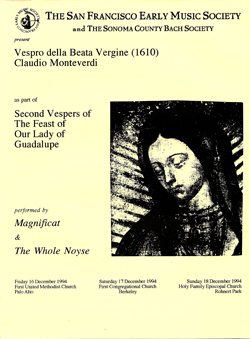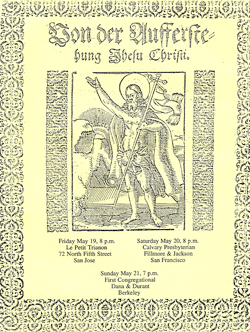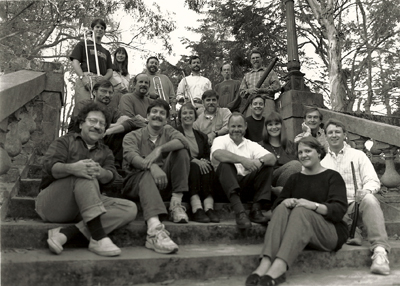1994-95: Magnificat’s Third Season
The enthusiastic response to Magnificat’s production of Cavalieri’s La Rappresentatione di Anima e di Corpo in Ferbuary 1994 led to a recording on the Koch International label. With recording sessions scheduled for the end of October, it wa decided to reduce the concert series to just two sets, but they were both extraordinary programs, each featuring monumental works from the 17th century: Claudio Monteverdi’s Vespers of 1610 and Heinrich Schütz’s Resurrection Story.
The recordings took place in the exquisitely beautiful chapel of St. Vincent’s School for Boys in Marinwood. Warren Stewart served as session producer together with engineer Peter Nothnagle.
The acoustics were perfect and in general there were few issues with ambient noise (always a concern with non-studio recording locations) until the third evening of sessions, when it was discovered to our surprise that the school had scheduled a “haunted house” as a fund-raiser in the rooms immediately adjacent to the chapel (it was the day before Halloween.) After some heated negotiations, we agreed to delay the start of our session until after the spooky fun was over, which meant that we were still recording at 2:00 am.
Proving his considerable skills as an audio magician, Peter had several innovative ideas for creating the various effects of spirits appearing and disappearing and the gates of hell opening and closing. The latter was achieved using two large flat stone found in the garden outside the chapel, which Warren scraped against each other. The recorded sound was then filtered through an audio technique called “pitch-shifting” and transposed (to the extent that the sound had “pitch”) to several different frequencies and then mixed them together with additional reverb. The result was worthy of Jimmy Page and even more frightening than the haunted house had been.
The title roles were sung by Judith Nelson and Paul Hiller and the recording included most of the cast from the February 1993 concerts together with the Whole Noyse. The recordings were edited and mixed and released by Koch in 1995.
With the recording completed, attention turned to Monteverdi’s music for Vespers. The concerts were a co-production with the San Francisco Early Music Society and the Sonoma Bach Society. Monteverdi’s psalms and Magnificat were performed within the context of Vespers for the Feast of Our Lady of Guadalupe and the sacri concerti included in the 1610 collection were used as antiphon substitutes.

As Susan and Warren wrote in the program notes for the December 1994 performances, “We have chosen the Feast of Our Lady of Guadalupe, for several reasons. The feast falls on December 12th, near the dates of our performances, and celebrates an appearance of Mary here in North America, to a Native American peasant near what is now Mexico City in 1531. The poetry of the texts for Guadalupe’s vespers is very beautiful, and compatible with Monteverdi’s choices for his antiphon substitutes; there is much flower imagery, in reference to the beautiful Castillian roses blooming in the dead of winter that were given by the Virgin to the peasant as a miraculous sign. It is also our hope that the choice of this feast, which was established only in 1754, a century and a half after Monteverdi’s publication, commemorating an event that took place in the New World, might take tonight’s performance even further out of the realm of historical reconstruction, and inspire reflection on the elusive relationships between music, performance, and time.”
In preparation for this program, Warren convinced Sacred Heart Catholic Church, in the Western Addition neighborhood where he was living, to allow him to lead a Tridentine Vespers every Thursday evening beginning in March of 1994. This practical experience of chanting the psalm tones and recitation formula was critical to his understanding of the rhythm and ritual of the Vespers liturgy that have served as the basis for so many Magnificat programs over the years. Magnificat Artistic Advisory Board members Jeffrey Kurtzman and William Mahrt both contributed considerably to this program.

In May 1995, Magnificat turned to the Resurrection Story of Heinrich Schütz. As with the Christmas Story in our first season (and again this December in our 20th) Martin Hummel sang the role of the Evangelist. For the Resurrection Story Schütz adapted the popular vocal style of the period called falso bordone, calling on a quartet of viols to sustain chords under the Evangelist’s reciting tone and bursting into expressive and florid part-writing at each cadence. The Sex Chordæ Consort of Viols played this striking and unique accompaniment of the Evangelist, and the Whole Noyse completed the instrumental ensemble.
For this program, Schütz’s music was performed within the context of Easter Vespers, following the chapel order of Johann Georg II, Elector of Saxony. In addition to tradional chant and Lutheran chorales, the program included a psalm from Schütz’s Psalmen Davids and works by Johann Hermann Schein, Samuel Scheidt and Michael Praetorius.
Over the course of the 1994-95 season, artistic directors Susan Harvey and Warren Stewart led ensembles that included Peter Becker, Amy Brodo, Mark Daniel, Hugh Davies,Rob Diggins, John Dornenburg, Elizabeth Engan, Ruth and Steve Escher, Richard Van Hessel, Paul Hillier, Martin Hummel,Boyd Jarrell, Julie Jeffrey, Doug Kirk, Bill Mathews, Andrew Morgan, Susan Rode Morris, Herb Myers, Phil Neumann, Ray Nurse, Farley Pearce, Neal Rogers, Michael Sand, Sandy Stadtfeld, David Stattelman, Bill Wahman, and Nat Watson.
